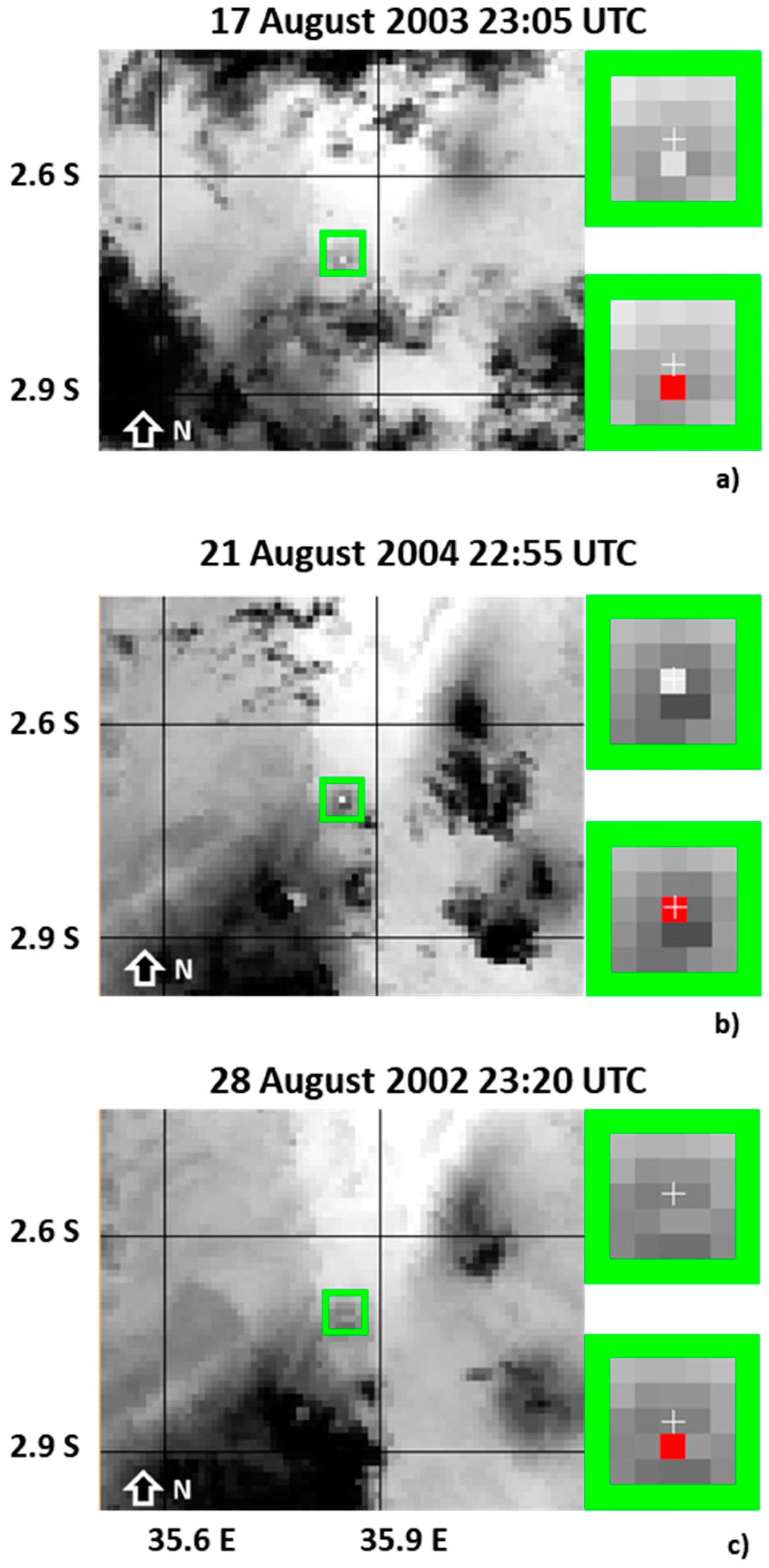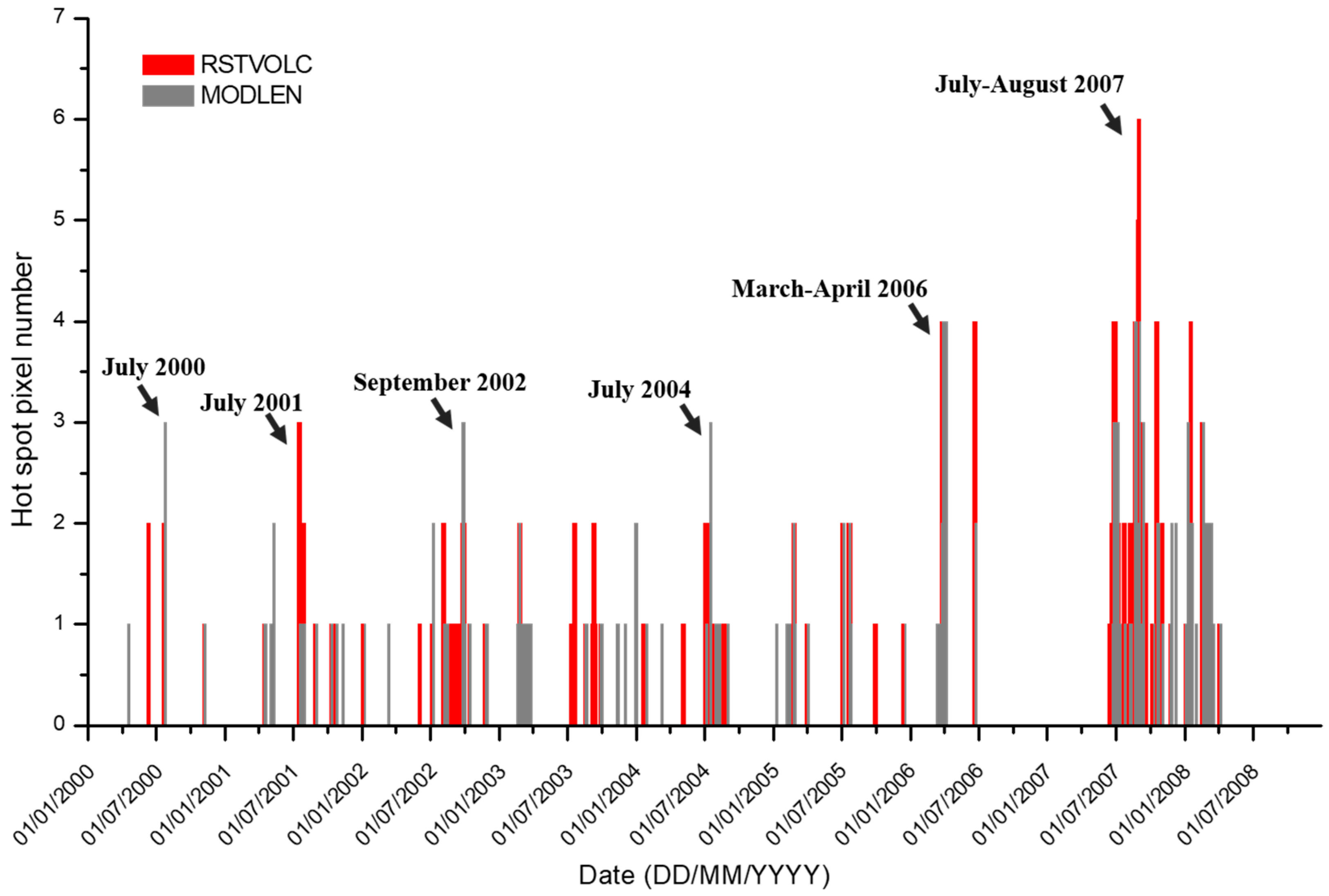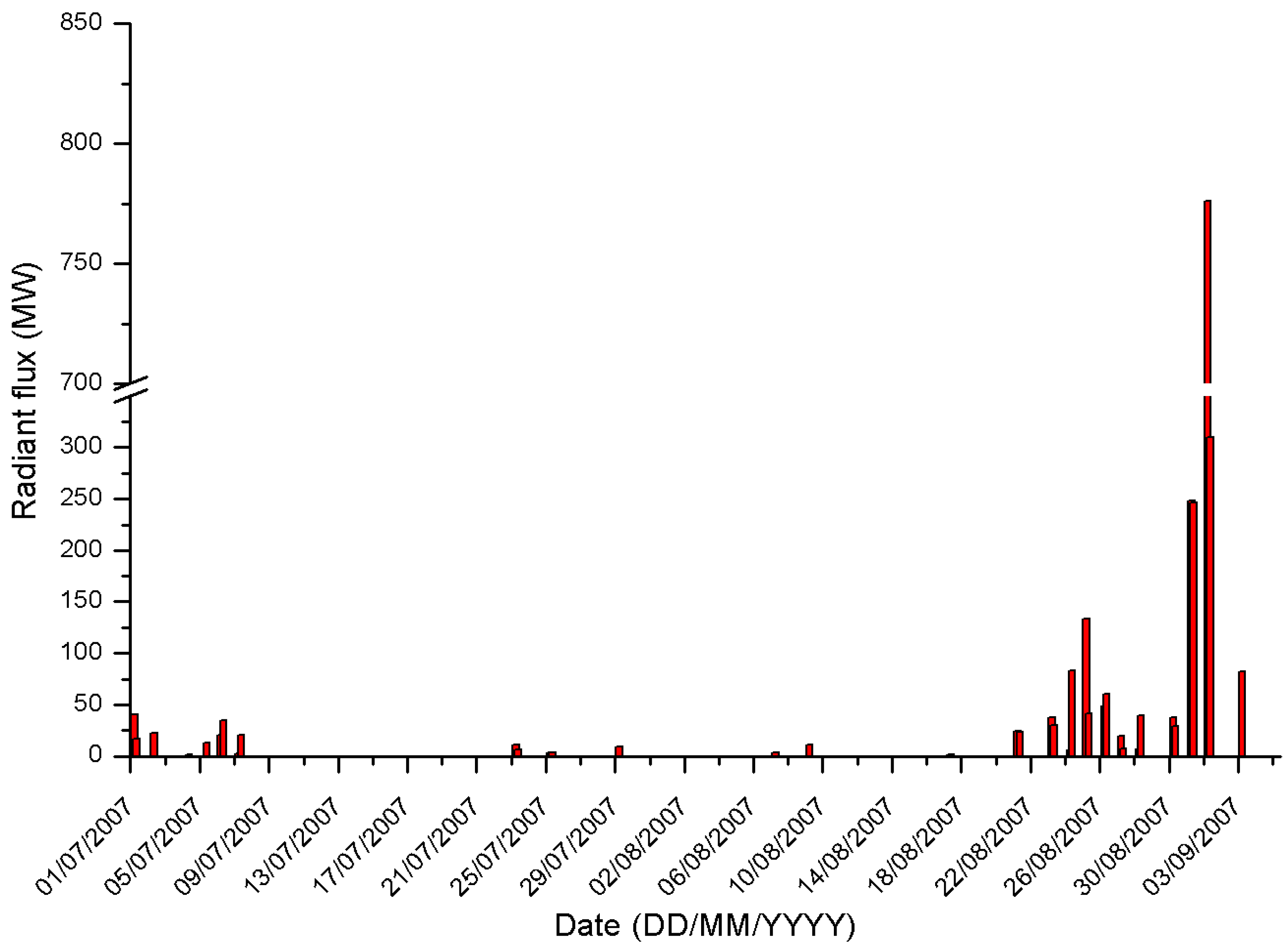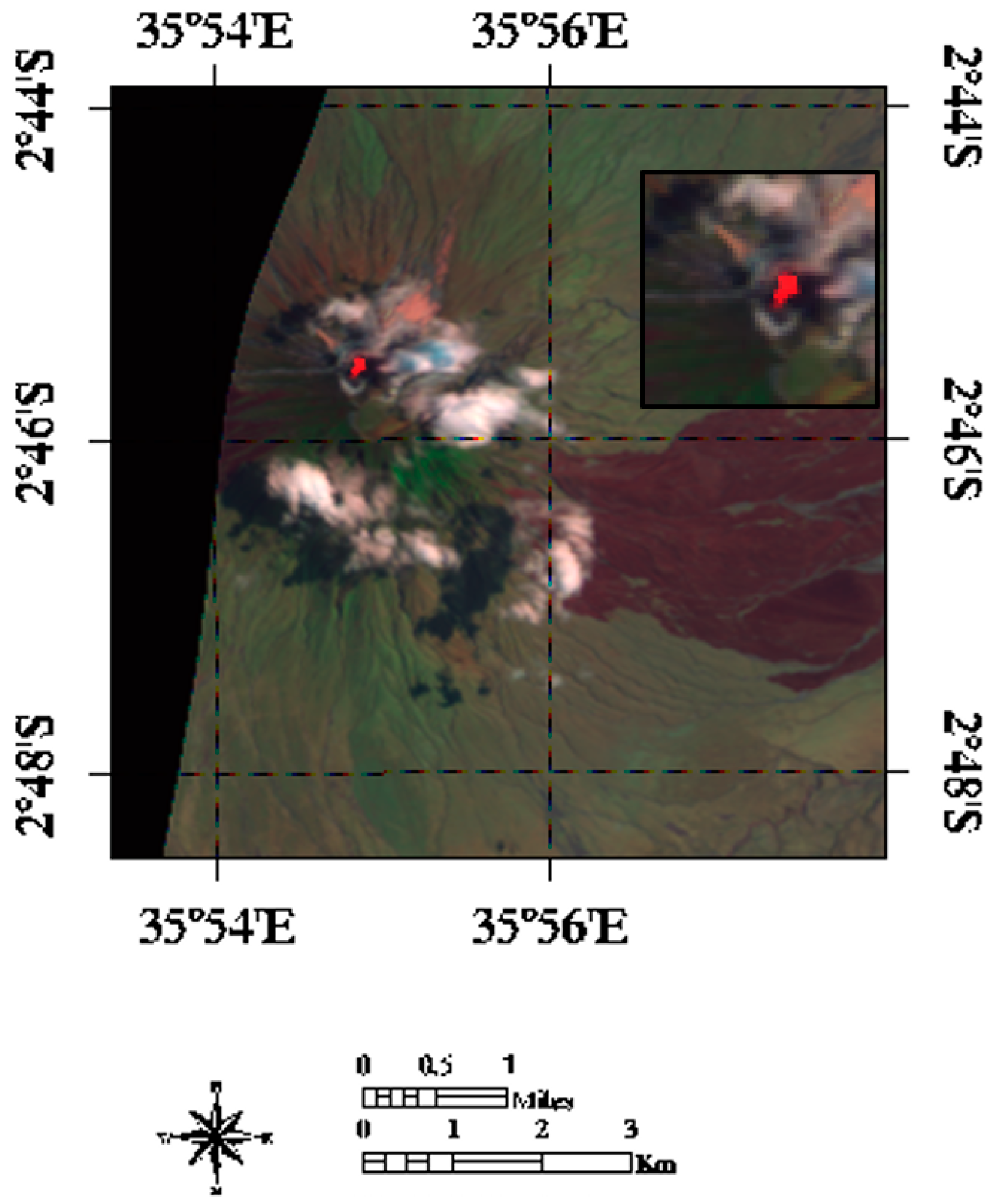Assessing Performance of the RSTVOLC Multi-Temporal Algorithm in Detecting Subtle Hot Spots at Oldoinyo Lengai (Tanzania, Africa) for Comparison with MODLEN
Abstract
1. Introduction
2. Oldoinyo Lengai Eruptive Activity
3. Satellite Methods
3.1. MODLEN
3.2. RSTVOLC
4. Data and Algorithm Implementation
5. Results
5.1. Assessment of RSTVOLC and MODLEN Detections
- We looked for the temporal agreement between flagged hot spots and documented eruptive activities of OL (e.g., [40,41,42,43,44]). The GVP bulletins usually provide information about the OL based on visual observations performed by visitors, single researchers and/or scientific teams. Since this information is generally less detailed than that reported by Frederick Belton (who carried out several field observations at OL during the period of interest) on his website [35]. We used both independent sources to assess thermal anomalies flagged by satellite.
- Field observations are infrequent and intermittent at OL. Therefore, it is realistic to suppose that a number of thermal activities occurring during the period of interest were unreported by both validation sources [30]. In order to take this limitation into account, and also considering the lava cooling process, we considered that thermal anomalies flagged within ±2 days from documented eruptions were associated to real (although undocumented) thermal activities of OL.
- High spatial resolution satellite data provided by sensors as ASTER (Advanced Spaceborne Thermal Emission and Reflection Radiometer) and ALI (Advanced Land Imaging) can also be used for assessing the presence of volcanic hot spots at OL. The low temporal resolution of those data (e.g., 16 days for both above-mentioned sensors), which is further reduced in presence of clouds, did not allow us for a systematic validation analysis of the detected thermal anomalies. As an example, by analyzing ASTER data made available from AVA (Aster Volcano Archive; https://ava.jpl.nasa.gov/granule.php?f=20040805200215) of the JPL (Jet Propulsion Laboratory), we found that only 13 granules independently returned hot spots for the OL during the period of interest, confirming limitations mentioned above (see Table 3). Considering only the ASTER hot spots at an average distance less than 1 km from the OL summit, eight of them indicate the occurrence of volcanic activity and six were temporally coincident with thermal anomalies identified by MODLEN and/or RSTVOLC.
- To assess if thermal anomalies that were not corroborated by the three above-mentioned validation steps represented artefacts or were rather associated to undocumented thermal activities of OL, we performed a manual inspection of infrared MODIS records, similar to previous independent studies [36]. This analysis, which was carried out by assessing the location and features (in terms of brightness temperature difference with the background) of detected hot spots, is similar to that independently performed in a previous literature study. This is where authors considered anomalous those pixels whose integrated temperature was elevated by 5 K above its neighbor (non-anomalous) ones [36,53]. In Figure 2, we show some examples of this investigation in reference to three different nighttime MODIS scenes of 2002–2004. In the figure, displaying the MIR channel in background, the green box indicates the OL volcanic area. The latter is magnified at the right side of each panel showing at the top the original field (brightest pixels are the more radiant ones), and at the bottom the detected thermal anomalies (in red). The top panel (Figure 2a) displays the nighttime MODIS data of 17 August 2003 at 23:05 UTC revealing that one of OL crater pixels was more radiant than neighbor ones. In particular, the value (292.19 K) of this image pixel, corresponding to that considered anomalous by both algorithms, was about 6.5 K above the background (i.e., the spatial mean calculated from the surrounding unperturbed pixels), confirming the occurrence of a thermal activity at OL. The mid panel (i.e., Figure 2b) shows another example of thermal anomaly which was correctly identified by satellite (on MODIS data of 21 August 2004 at 22:55 UTC). This hot spot, flagged only by RSTVOLC (MODLEN did not detect this feature because of the NTI value slightly lower than the used threshold), had the same characteristics of that reported in Figure 2a in terms of location and difference with the background. Hence, it may be similarly ascribed to an undocumented thermal activity of OL. The bottom panel (i.e., Figure 2c) shows instead an example of false detection. Indeed, the value (287.56 K) of the pixel flagged as anomalous by RSTVOLC (on MODIS data of 28 August at 23:20 UTC) was only about 2 K higher than background = 285.5 K), revealing the generation of an artefact.
5.2. Quantifying Thermal Emissions at OL
6. Discussion
- Clouds: About 36% of analyzed MODIS scenes were completely overcast over the OL summit area, as indicated by the OCA method. As an example, because of cloud coverage both RSTVOLC and MODLEN undetected the explosive eruption of 4 September 2007, which was presumably accompanied by a strong thermal activity in the crater and by lava flows to the west and northwest [32].
- Short-lived eruptions (e.g., strombolian paroxysms; lava fountains): These events, common at OL [31], may be undetected from space due to timing of satellite overpasses [57]. In addition, in our case, we analyzed only nighttime scenes further reducing the probability of detecting short-lived events occurring in daylight conditions.
- Satellite viewing geometry: Weak thermal activities (e.g., minor intra-crater eruptions) generating hot spots of low temperature and/or spatial extent are more difficult to identify from space when satellite data are acquired under unfavorable viewing conditions (i.e., high zenith angles) (e.g., [7]).
7. Conclusions
Author Contributions
Funding
Acknowledgments
Conflicts of Interest
References
- Gawarecki, S.J.; Lyon, R.J.P.; Nordberg, W. Infrared spectral returns and imagery of the Earth from space and their application to geological problems. Sci. Technol. Ser. Am. Astron. Soc. 1965, 4, 13–33. [Google Scholar]
- Rothery, D.A.; Francis, P.W.; Wood, C.A. Volcano monitoring using short wavelength infrared data from satellites. J. Geophys. Res. Solid Earth 1998, 93, 7993–8008. [Google Scholar] [CrossRef]
- Glaze, L.; Francis, P.W.; Rothery, D.A. Measuring thermal budgets of active volcanoes by satellite remote sensing. Nature 1989, 338, 144–146. [Google Scholar] [CrossRef]
- Oppenheimer, C. Lava flow cooling estimated from Landsat Thematic Mapper infrared data: The Lonquimay eruption (Chile, 1989). J. Geophys. Res. Solid Earth 1991, 96, 21865–21878. [Google Scholar] [CrossRef]
- Vaughan, R.; Rothery, D. Volcano detection and monitoring using AVHRR data: The Krafla eruption, 1984. Remote Sens. 1995, 16, 1001–1020. [Google Scholar]
- Harris, A.J.L.; Swabey, S.E.J.; Higgins, J. Automated thresholding of active lavas using AVHRR data. Int. J. Remote Sens. 1995, 16, 3681–3686. [Google Scholar] [CrossRef]
- Dehn, J.; Dean, K.G.; Engle, K.; Izbekov, P. Thermal precursors in satellite images of the 1999 eruption of Shishaldin Volcano. Bull. Volcanol. 2002, 64, 525–534. [Google Scholar] [CrossRef]
- Wright, R.; Flynn, L.P. On the retrieval of lava-flow surface temperatures from infrared satellite data. Geology 2003, 31, 893–896. [Google Scholar] [CrossRef]
- Ernst, G.G.J.; Kervyn, M.; Teeuw, R.M. Advances in the remote sensing of volcanic activity and hazards, with special consideration for applications in developing countries. Int. J. Remote Sens. 2008, 29, 6687–6723. [Google Scholar] [CrossRef]
- Coppola, D.; Piscopo, D.; Staudacher, T.; Cigolini, C. Lava discharge rate and effusive pattern at Piton de la Fournaise from MODIS data. J. Volcanol. Geotherm. Res. 2009, 184, 174–192. [Google Scholar] [CrossRef]
- Worden, A.; Dehn, J.; Webley, P. Frequency based satellite monitoring of small scale explosive activity at remote North Pacific volcanoes. J. Volcanol. Geotherm. Res. 2014, 286, 1–14. [Google Scholar] [CrossRef]
- Miller, P.I.; Harris, A.J. Near-real-time service provision during effusive crises at Etna and Stromboli: Basis and implementation of satellite-based IR operations. Geol. Soc. Lond. Spec. Publ. 2016, 426, SP426-26. [Google Scholar] [CrossRef]
- Dean, K.; Servilla, M.; Roach, A.; Foster, B.; Engle, K. Satellite monitoring of remote volcanoes improves study efforts in Alaska. Eos Trans. Am. Geophys. Union 1998, 79, 413–423. [Google Scholar] [CrossRef]
- Webley, P.W.; Wooster, M.J.; Strauch, W.; Saballos, J.A.; Dill, K.; Stephenson, P.; Escobar Wolf, R.; Matias, O. Experiences from near-real-time satellite-based volcano monitoring in Central America: Case studies at Fuego, Guatemala. Int. J. Remote Sens. 2008, 29, 6621–6646. [Google Scholar] [CrossRef]
- Pergola, N.; Marchese, F.; Tramutoli, V. Automated detection of thermal features of active volcanoes by means of infrared AVHRR records. Remote Sens. Environ. 2004, 93, 311–327. [Google Scholar] [CrossRef]
- Higgins, J.; Harris, A. VAST: A program to locate and analyse volcanic thermal anomalies automatically from remotely sensed data. Comput. Geosci. 1997, 23, 627–645. [Google Scholar] [CrossRef]
- Marchese, F.; Pergola, N.; Telesca, L. Investigating the temporal fluctuations in satellite Advanced Very High Resolution Radiometer thermal signals measured in the volcanic area of Etna (Italy). Fluct. Noise Lett. 2006, 6, L305–L316. [Google Scholar] [CrossRef]
- Lovallo, M.; Marchese, F.; Pergola, N.; Telesca, L. Fisher information analysis of volcano-related advanced, very-high-resolution radiometer (AVHRR) thermal products time series. Phys. A Stat. Mech. Appl. 2007, 384, 529–534. [Google Scholar] [CrossRef]
- Lombardo, V. AVHotRR: Near-real time routine for volcano monitoring using IR satellite data. Geol. Soc. Lond. Spec. Publ. 2015, 426, SP426-18. [Google Scholar] [CrossRef]
- Wright, R.; Flynn, L.; Garbeil, H.; Harris, A.; Pilger, E. Automated volcanic eruption detection using MODIS. Remote Sens. Environ. 2002, 82, 135–155. [Google Scholar] [CrossRef]
- Wright, R.; Pilger, E. Radiant flux from Earth’s subaerially erupting volcanoes. Int. J. Remote Sens. 2008, 29, 6443–6466. [Google Scholar] [CrossRef]
- Wright, R.; Blackett, M.; Hill-Butler, C. Some observations regarding the thermal flux from Earth’s erupting volcanoes for the period of 2000 to 2014. Geophys. Res. Lett. 2015, 42, 282–289. [Google Scholar] [CrossRef]
- Ganci, G.; Vicari, A.; Cappello, A.; Del Negro, C. An emergent strategy for volcano hazard assessment: From thermal satellite monitoring to lava flow modeling. Remote Sens. Environ. 2012, 119, 197–207. [Google Scholar] [CrossRef]
- Marchese, F.; Lacava, T.; Pergola, N.; Hattori, K.; Miraglia, E.; Tramutoli, V. Inferring phases of thermal unrest at Mt. Asama (Japan) from infrared satellite observations. J. Volcanol. Geotherm. Res. 2012, 237, 10–18. [Google Scholar] [CrossRef]
- Coppola, D.; Laiolo, M.; Cigolini, C.; Delle Donne, D.; Ripepe, M. Enhanced volcanic hot-spot detection using MODIS IR data: Results from the MIROVA system. Geol. Soc. Lond. Spec. Publ. 2016, 426, 181–205. [Google Scholar] [CrossRef]
- Coppola, D.; Laiolo, M.; Lara, L.E.; Cigolini, C.; Orozco, G. The 2008 “silent” eruption of Nevados de Chillán (Chile) detected from space: Effusive rates and trends from the MIROVA system. J. Volcanol. Geotherm. Res. 2016. [Google Scholar] [CrossRef]
- Marchese, F.; Filizzola, C.; Genzano, N.; Mazzeo, G.; Pergola, N.; Tramutoli, V. Assessment and improvement of a Robust Satellite Technique (RST) for thermal monitoring of volcanoes. Remote Sens. Environ. 2011, 115, 1556–1563. [Google Scholar] [CrossRef]
- Pergola, N.; Coviello, I.; Filizzola, C.; Lacava, T.; Marchese, F.; Paciello, R.; Tramutoli, V. A review of RSTVOLC, an original algorithm for automatic detection and near-real-time monitoring of volcanic hotspots from space. Geol. Soc. Lond. Spec. Publ. 2015, 426, SP426-1. [Google Scholar] [CrossRef]
- Di Genova, D.; Cimarelli, C.; Hess, K.; Dingwell, D.B. An advanced rotational rheometer system for extremely fluid liquids up to 1273 K and applications to alkali carbonate melts. Am. Mineral. 2016, 101, 953–959. [Google Scholar] [CrossRef]
- Kervyn, M.; Ernst, G.G.J.; Harris, A.; Mbede, E.; Belton, F.; Jacobs, P. Thermal remote sensing of the low-intensity carbonatite volcanism of Oldoinyo Lengai, Tanzania. Int. J. Remote Sens. 2008, 29, 6467–6499. [Google Scholar] [CrossRef]
- Dawson, J.B.; Bowden, P.; Clark, G.C. Activity of the carbonatite volcano Oldoinyo Lengai. Geol. Rundsch. 1968, 57, 865–879. [Google Scholar] [CrossRef]
- Dawson, J.B.; Pinkerton, H.; Pyle, D.M.; Nyamweru, C. June 1993 eruption of Oldoinyo Lengai, Tanzania: Exceptionally viscous and large carbonatite lava flows and evidence for coexisting silicate and carbonate magmas. Geology 1994, 22, 799–802. [Google Scholar] [CrossRef]
- Kervyn, M.; Ernst, G.G.; Klaudius, J.; Keller, J.; Kervyn, F.; Mattsson, H.B.; Belton, F.; Mbede, E.; Jacobs, P. Voluminous lava flows at Oldoinyo Lengai in 2006: Chronology of events and insights into the shallow magmatic system. Bull. Volcanol. 2008, 70, 1069–1086. [Google Scholar] [CrossRef]
- Vaughan, R.G.; Kervyn, M.; Realmuto, V.; Abrams, M.; Hook, S.J. Satellite measurements of recent volcanic activity at Oldoinyo Lengai, Tanzania. J. Volcanol. Geotherm. Res. 2008, 173, 196–206. [Google Scholar] [CrossRef]
- Belton, F. Ol Doinyo Lengai, the Mountain of God. Available online: http://oldoinyolengai.pbworks.com/w/page/33191422/Ol%20Doinyo%20Lengai%2C%20The%20Mountain%20of%20God (accessed on 15 July 2018).
- Steffke, A.M.; Harris, A.J. A review of algorithms for detecting volcanic hot spots in satellite infrared data. Bull. Volcanol. 2011, 73, 1109–1137. [Google Scholar] [CrossRef]
- Kervyn, M.; Ernst, G.G.; Keller, J.; Vaughan, R.G.; Klaudius, J.; Pradal, E.; Belton, F.; Mattsson, H.B.; Mbede, E.; Jacobs, P. Fundamental changes in the activity of the natrocarbonatite volcano Oldoinyo Lengai, Tanzania. II. Eruptive behaviour during the 2007–2008 explosive eruptions. Bull. Volcanol. 2010, 72, 913–931. [Google Scholar] [CrossRef]
- De Schutter, A.; Kervyn, M.; Stadlin-Bosshard, S.; Songo, M.; Mattsson, H. Ash fall impact on vegetation: A remote sensing approach of the 2007-08 Oldoinyo Lengai eruption. J. Appl. Volcanol. 2015, 4, 15. [Google Scholar] [CrossRef]
- Keller, J.; Klaudius, J.; Kervyn, M.; Ernst, G.G.; Mattsson, H.B. Fundamental changes in the activity of the natrocarbonatite volcano Oldoinyo Lengai, Tanzania. Bull. Volcanol. 2010, 72, 893–912. [Google Scholar] [CrossRef]
- Global Volcanism Program. Report on Ol Doinyo Lengai (Tanzania). In Bulletin of the Global Volcanism Network; Wunderman, R., Ed.; Smithsonian Institution: Washington, DC, USA, 1998; Volume 23. [Google Scholar]
- Global Volcanism Program. Report on Ol Doinyo Lengai (Tanzania). In Bulletin of the Global Volcanism Network; Wunderman, R., Ed.; Smithsonian Institution: Washington, DC, USA, 2002; Volume 27. [Google Scholar]
- Global Volcanism Program. Report on Ol Doinyo Lengai (Tanzania). In Bulletin of the Global Volcanism Network; Venzke, E., Ed.; Smithsonian Institution: Washington, DC, USA, 2003; Volume 28. [Google Scholar]
- Global Volcanism Program. Report on Ol Doinyo Lengai (Tanzania). In Bulletin of the Global Volcanism Network; Venzke, E., Ed.; Smithsonian Institution: Washington, DC, USA, 2004; Volume 29. [Google Scholar]
- Global Volcanism Program. Report on Ol Doinyo Lengai (Tanzania). In Bulletin of the Global Volcanism Network; Wunderman, R., Ed.; Smithsonian Institution: Washington, DC, USA, 2005; Volume 30. [Google Scholar]
- Mitchell, R.H.; Dawson, J.B. The 24th September 2007 ash eruption of the carbonatite volcano Oldoinyo Lengai, Tanzania: Mineralogy of the ash and implications for formation of a new hybrid magma type. Mineral. Mag. 2007, 71, 483–492. [Google Scholar] [CrossRef]
- Van Manen, S.; Kervyn, M.; Blake, S.; Ernst, G.G.J. Apparent tidal influence on magmatic activity at Oldoinyo Lengai volcano, Tanzania, as observed in Moderate resolution Imaging Spectroradiometer (MODIS) data. J. Volcanol. Geotherm. Res. 2010, 189, 151–157. [Google Scholar] [CrossRef]
- Tramutoli, V. Robust satellite techniques (RST) for natural and environmental hazards monitoring and mitigation: Theory and applications. In Proceedings of the 2007 International Workshop on the Analysis of Multi-Temporal Remote Sensing Images, Leuven, Belgium, 18–20 July 2007. [Google Scholar]
- Di Bello, G.; Filizzola, C.; Lacava, T.; Marchese, F.; Pergola, N.; Pietrapertosa, C.; Piscitelli, S.; Scaffidi, I.; Tramutoli, V. Robust satellite technique for volanic and seismic hazard monitoring. Ann. Geophys. 2004, 47, 49–64. [Google Scholar]
- Pergola, N.; Marchese, F.; Tramutoli, V.; Filizzola, C.; Ciampa, M. Advanced satellite technique for volcanic activity monitoring and early warning. Ann. Geophys. 2008, 51, 287–301. [Google Scholar]
- Marchese, F.; Ciampa, M.; Filizzola, C.; Mazzeo, G.; Lacava, T.; Pergola, N.; Tramutoli, V. On the exportability of Robust Satellite Techniques (RST) for active volcanoes monitoring. Remote Sens. 2010, 2, 1575–1588. [Google Scholar] [CrossRef]
- Cuomo, V.; Filizzola, C.; Pergola, N.; Pietrapertosa, C.; Tramutoli, V. A self-sufficient approach for GERB cloudy radiance detection. Atmos. Res. 2004, 72, 39–56. [Google Scholar] [CrossRef]
- Lacava, T.; Marchese, F.; Arcomano, G.; Coviello, I.; Falconieri, A.; Faruolo, M.; Pergola, N.; Tramutoli, V. Thermal monitoring of Eyjafjöll volcano eruptions by means of infrared MODIS data. IEEE J. Select. Top. Appl. Earth Obs. Remote Sens. 2014, 7, 3393–3401. [Google Scholar] [CrossRef]
- Van Manen, S.M.; Dehn, J. Satellite remote sensing of thermal activity at Bezymianny and Kliuchevskoi from 1993 to 1998. Geology 2009, 37, 983–986. [Google Scholar] [CrossRef]
- Global Volcanism Program. Report on Ol Doinyo Lengai (Tanzania). In Bulletin of the Global Volcanism Network; Wunderman, R., Ed.; Smithsonian Institution: Washington, DC, USA, 2007; Volume 32. [Google Scholar]
- Giglio, L. MODIS Collection 5 Active Fire Product User’s Guide, Version 2.5; University of Maryland: College Park, MD, USA, 2013; 61p. [Google Scholar]
- Kaufman, Y.J.; Justice, C.O.; Flynn, L.P.; Kendall, J.D.; Prins, E.M.; Giglio, L.; Ward, D.E.; Menzel, W.P.; Setzer, A.W. Potential global fire monitoring from EOS-MODIS. J. Geophys. Res. 1998, 103, 32215–32238. [Google Scholar] [CrossRef]
- Worden, A.; Dehn, J.; Ripepe, M.; Delle Donne, D. Frequency based detection and monitoring of small scale explosive activity by comparing satellite and ground based infrared observations at Stromboli Volcano, Italy. J. Volcanol. Geotherm. Res. 2014, 283, 159–171. [Google Scholar] [CrossRef]
- Marchese, F.; Falconieri, A.; Pergola, N.; Tramutoli, V. A retrospective analysis of the Shinmoedake (Japan) eruption of 26–27 January 2011 by means of Japanese geostationary satellite data. J. Volcanol. Geotherm. Res. 2014, 269, 1–13. [Google Scholar] [CrossRef]
- Marchese, F.; Filizzola, C.; Mazzeo, G.; Paciello, R.; Pergola, N.; Tramutoli, V. Robust Satellite Techniques for thermal volcanic activity monitoring, early warning and possible prediction of new eruptive events. In Proceedings of the 2009 IEEE International Geoscience and Remote Sensing Symposium, Cape Town, South Africa, 12–17 July 2009; Volume 2. [Google Scholar]
- Ganci, G.; Harris, A.J.L.; Del Negro, C.; Guehenneux, Y.; Cappello, A.; Labazuy, P.; Calvari, S.; Gouhier, M. A year of lava fountaining at Etna: Volumes from SEVIRI. Geophys. Res. Lett. 2012, 39, L06305. [Google Scholar] [CrossRef]






| Month | Aqua-MODIS | Terra-MODIS |
|---|---|---|
| January | 164 | 180 |
| February | 149 | 168 |
| March | 159 | 192 |
| April | 150 | 194 |
| May | 161 | 214 |
| June | 160 | 207 |
| July | 224 | 283 |
| August | 222 | 271 |
| September | 220 | 275 |
| October | 190 | 207 |
| November | 182 | 202 |
| December | 190 | 200 |
| Total | 2171 | 2593 |
| Year | RSTVOLC | MODLEN | Common Hot Spot Detections |
|---|---|---|---|
| 2000 | 3 | 3 | 2 |
| 2001 | 9 | 11 | 8 |
| 2002 | 24 | 14 | 11 |
| 2003 | 13 | 17 | 7 |
| 2004 | 18 | 12 | 8 |
| 2005 | 13 | 15 | 7 |
| 2006 | 10 | 15 | 6 |
| 2007 | 67 | 55 | 36 |
| 2008 | 15 | 23 | 14 |
| Total | 172 | 165 | 99 |
| ASTER Acquisition Date (DD/MM/YYYY HH:MM) | Average Distance from OL Summit (km) | MODIS Acquisition Date (DD/MM/YYYY HH:MM) | MODLEN | RSTVOLC |
|---|---|---|---|---|
| 15/10/2002 08:10 | 28.46 | |||
| 08/03/2003 08:41 | 31.58 | |||
| 19/03/2003 08:33 | 32.86 | |||
| 05/08/2004 08:15 | 0.88 | 05/08/2004 20:20 | Yes | Yes |
| 01/11/2005 08:07 | 63.6 | |||
| 04/09/2007 08:13 | 0.61 | 03/09/2007 19:35 | Yes | Yes |
| 22/09/2007 08:01 | 32.24 | |||
| 17/10/2007 08:36 | 0.79 | 17/10/2007 20:00 | Yes | Yes |
| 23/11/2007 08:43 | 0.71 | 23/11/2007 20:20 | Yes | No |
| 25/11/2007 08:37 | 0.52 | 25/11/2007 20:05 | Yes | Yes |
| 02/02/2008 08:14 | 0.67 | 02/02/2008 20:25 | No | No |
| 29/02/2008 08:48 | 0.48 | 29/02/2008 23:00 | Yes | Yes |
| 05/03/2008 08:03 | 0.59 | 05/03/2008 20:25 | No | No |
| Hot Spots Confirmed by Field Observations or Occurring within ±2 Days Documented Eruptions | Hot Spots Confirmed by Manual Inspection of MODIS Data | False Positive Rate | |
|---|---|---|---|
| MODLEN | 44.0% | 48.2% | 7.8% |
| RSTVOLC | 56.8% | 40.9% | 2.3% |
© 2018 by the authors. Licensee MDPI, Basel, Switzerland. This article is an open access article distributed under the terms and conditions of the Creative Commons Attribution (CC BY) license (http://creativecommons.org/licenses/by/4.0/).
Share and Cite
Lacava, T.; Kervyn, M.; Liuzzi, M.; Marchese, F.; Pergola, N.; Tramutoli, V. Assessing Performance of the RSTVOLC Multi-Temporal Algorithm in Detecting Subtle Hot Spots at Oldoinyo Lengai (Tanzania, Africa) for Comparison with MODLEN. Remote Sens. 2018, 10, 1177. https://doi.org/10.3390/rs10081177
Lacava T, Kervyn M, Liuzzi M, Marchese F, Pergola N, Tramutoli V. Assessing Performance of the RSTVOLC Multi-Temporal Algorithm in Detecting Subtle Hot Spots at Oldoinyo Lengai (Tanzania, Africa) for Comparison with MODLEN. Remote Sensing. 2018; 10(8):1177. https://doi.org/10.3390/rs10081177
Chicago/Turabian StyleLacava, Teodosio, Matthieu Kervyn, Mariangela Liuzzi, Francesco Marchese, Nicola Pergola, and Valerio Tramutoli. 2018. "Assessing Performance of the RSTVOLC Multi-Temporal Algorithm in Detecting Subtle Hot Spots at Oldoinyo Lengai (Tanzania, Africa) for Comparison with MODLEN" Remote Sensing 10, no. 8: 1177. https://doi.org/10.3390/rs10081177
APA StyleLacava, T., Kervyn, M., Liuzzi, M., Marchese, F., Pergola, N., & Tramutoli, V. (2018). Assessing Performance of the RSTVOLC Multi-Temporal Algorithm in Detecting Subtle Hot Spots at Oldoinyo Lengai (Tanzania, Africa) for Comparison with MODLEN. Remote Sensing, 10(8), 1177. https://doi.org/10.3390/rs10081177









